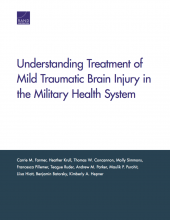By the Numbers - May 2, 2016
30-50 percent
The percentage of injuries to Service members in the recent Iraq/Afghanistan conflicts that came from improvised explosive devices (IED), according to a new report from the RAND Corporation -- Understanding Treatment of Mild Traumatic Brain Injury in the Military Health System.
A research brief based on the report -- Characteristics and Treatment Patterns of Service Members with Mild Traumatic Brain Injury -- notes that although TBI is "a frequent consequence" of IED explosions, "most TBIs occur while service members are not deployed and are the result of training accidents, falls, sports, motor vehicle crashes, and other high-impact trauma." Of these head injuries, 84 percent "are considered mild TBIs (mTBIs), or concussions."
The report suggests that understanding the characteristics of Service members with mTBI will assist the military health system in providing high quality care. The report found:
- Service members who received treatment for a new mTBI diagnosis in 2012 tended to be young and junior enlisted.
- Most service members appeared to recover quickly following their mTBI diagnosis, but a minority had complex and persistent care needs.
- Most service members with a new mTBI diagnosis were diagnosed in an emergency department and had their next health care visit in a primary care setting.
- Many service members with a new mTBI diagnosis also received treatment for co-occurring behavioral health conditions, pain, and sleep disorders.
- Service members with a new mTBI diagnosis received a variety of assessments and treatments, such as CT scans, physical therapy, and pain medication, in the six months following the mTBI diagnosis, but there were differences by whether the service member had experienced a prior TBI.
30-50 percent
The percentage of injuries to Service members in the recent Iraq/Afghanistan conflicts that came from improvised explosive devices (IED), according to a new report from the RAND Corporation -- Understanding Treatment of Mild Traumatic Brain Injury in the Military Health System.
A research brief based on the report -- Characteristics and Treatment Patterns of Service Members with Mild Traumatic Brain Injury -- notes that although TBI is "a frequent consequence" of IED explosions, "most TBIs occur while service members are not deployed and are the result of training accidents, falls, sports, motor vehicle crashes, and other high-impact trauma." Of these head injuries, 84 percent "are considered mild TBIs (mTBIs), or concussions."
The report suggests that understanding the characteristics of Service members with mTBI will assist the military health system in providing high quality care. The report found:
- Service members who received treatment for a new mTBI diagnosis in 2012 tended to be young and junior enlisted.
- Most service members appeared to recover quickly following their mTBI diagnosis, but a minority had complex and persistent care needs.
- Most service members with a new mTBI diagnosis were diagnosed in an emergency department and had their next health care visit in a primary care setting.
- Many service members with a new mTBI diagnosis also received treatment for co-occurring behavioral health conditions, pain, and sleep disorders.
- Service members with a new mTBI diagnosis received a variety of assessments and treatments, such as CT scans, physical therapy, and pain medication, in the six months following the mTBI diagnosis, but there were differences by whether the service member had experienced a prior TBI.

